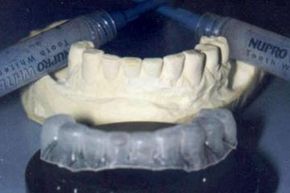Dentist-supervised tooth whitening involves the controlled use of carbamide or hydrogen peroxide, tailored to a particular patient. Dentists may administer in-office treatments or at-home treatments.
Before the tooth whitening treatment, most dentists clean the teeth, fill any cavities, and make sure the patient's gums are healthy.
Most in-office systems use 15 to 35 percent hydrogen peroxide gels, sometimes coupled with a high intensity light to expedite the bleaching chemical reaction. (Some recent research has questioned the need and effectiveness of the light source used during in-office tooth whitening.)
The in-office procedure involves the dentist gently cleaning your teeth with pumice and then putting a protective barrier on the gums. The dentist then places hydrogen peroxide paste on the teeth for several minutes, rinses it off, and usually reapplies it several times. The procedure can achieve about four to six shades of whitening after only one 40-minute treatment.
At-home systems will often use 10 to 20 percent carbamide peroxide gels that also contain glycerin, carbomer, sodium hydroxide, water, and flavoring agents. Some gels that contain more than 10 percent carbamide peroxide will also include sodium fluoride to reduce sensitivity and strengthen teeth.
To begin the at-home procedure, the dentist takes impressions (molds) of your mouth, and then has soft, custom mouth trays made. To administer the treatment, the you put a thin ribbon of the gel into the tray and wears it for two hours during the day, or while sleeping. Most whitening occurs in one to two weeks. In difficult cases, trays may need to be worn for up to six weeks.
A combination of in-office and at-home systems can achieve up to 12 to 15 shades of whitening in most patients. At-home systems used alone can obtain similar results, but may take longer. These procedures are considered safe and effective when monitored by a dentist.
Dentist supervised systems have advantages and disadvantages when compared to over-the-counter tooth whitening products. The main advantage of the dentist supervised system is that the dentist can help determine if tooth whitening should be performed and if it will be effective for the patient. Patients with decayed teeth, infected gums, white spots on their teeth, and multiple tooth colored fillings or crowns (caps) on the front teeth may not be good candidates for tooth whitening.
The dentist can also help decide what type of tooth whitening is required (in-office, at-home or both) and the concentration of the whitening gels. The dentist can monitor and treat patients who experience sensitivity to the whitening agents and modify the procedure for those who are having difficulty getting optimal results. Finally, the dentist can help the patient explore other cosmetic dental options such as porcelain or resin veneers, tooth colored fillings, gum lifts and tooth shaping used with or without tooth whitening. With the help of the dentist, the patient's cosmetic dental goals may be more easily attained.
The disadvantages of dentist supervised whitening systems include higher cost and longer time required to get started. The in-office and at-home tooth whitening systems can cost between $300-$1,000 (sometimes more). In most cases, at-home systems cost less than the in-office systems. With the dentist supervised systems, there may be a wait to get started. You have to schedule an appointment, wait to be seen and evaluated, and then be treated.



